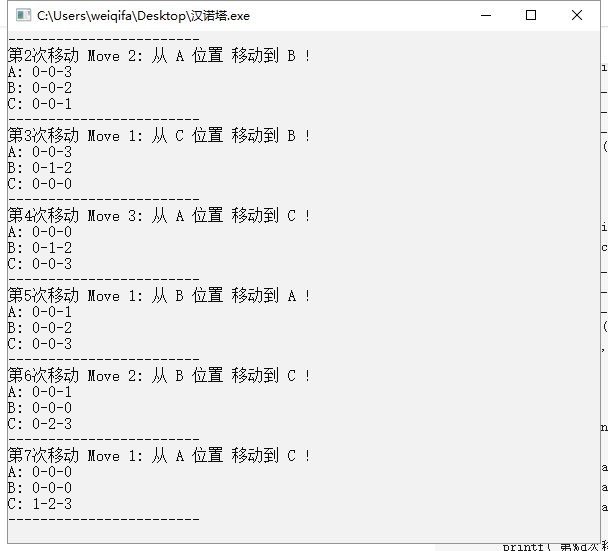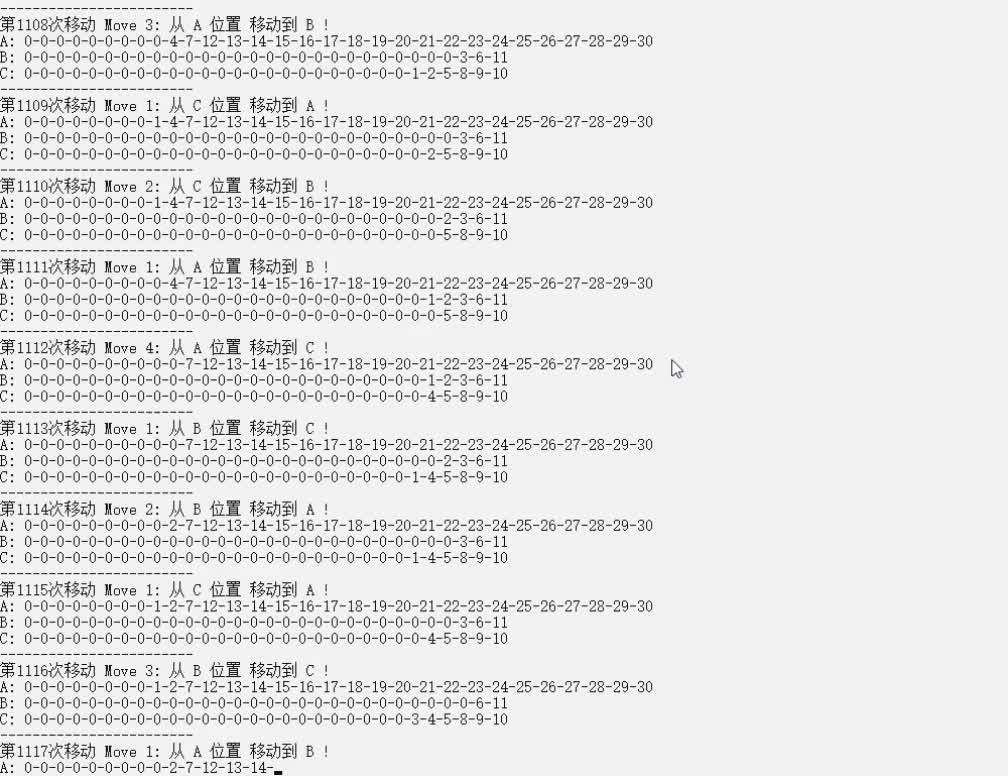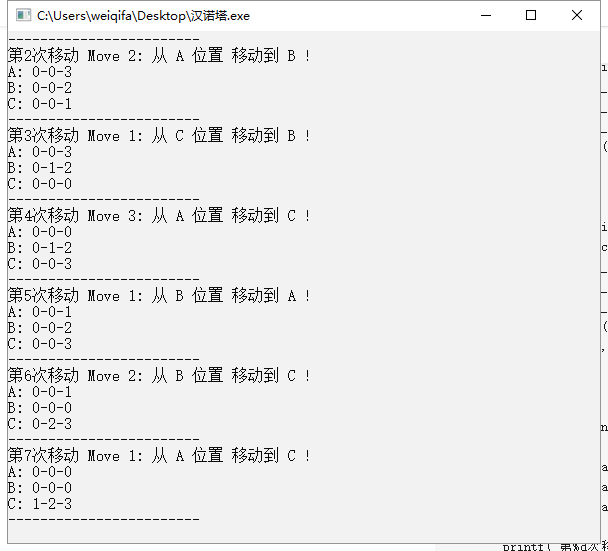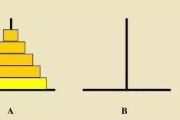#include <stdio.h>
#include <stdlib.h>
#include <string.h>
#include <Windows.h>
/*柔性数组*/
typedef struct _soft_array{
int len;
int array[];
}soft_array;
/*汉诺塔结构体*/
typedef struct _hannuo{
soft_array *p_data;
char name;
}hannuo;
hannuo * han_a = NULL;
hannuo * han_b = NULL;
hannuo * han_c = NULL;
void hannoiii(int n,hannuo * a,hannuo * b,hannuo * c);
void moveiii (int n,hannuo * a,hannuo * c);
int count = 0;
int total;
void printf_han_data(hannuo * han)
{
int i = 0;
int j = 0;
int tmp = 0;
/*获取长度*/
int n = han->p_data->len;
soft_array *p_array = NULL;
/*申请内存,赋值数据*/
p_array = (soft_array*)malloc(sizeof(soft_array)+sizeof(int)*n);
memcpy(p_array,han->p_data,sizeof(soft_array)+sizeof(int)*n);
printf("%c: ",han->name);
/*排序*/
for(i = 0;i<n;i++)
{
for(j=0;j<n-1;j++)
{
if(p_array->array[j] > p_array->array[j+1])
{
tmp = p_array->array[j];
p_array->array[j] = p_array->array[j+1];
p_array->array[j+1] = tmp;
}
}
}
/*输出汉诺塔的数据*/
for(i = 0;i<n;i++)
{
if(i != n-1)
printf("%d-",p_array->array[i]);
else
printf("%d",p_array->array[i]);
}
/*释放内存*/
if(p_array != NULL)
free(p_array);
printf("\n");
}
int main()
{
int i = 0;
int n = 0;
scanf(" %d",&n);
total = n;
/*定义三个汉诺塔节点*/
han_a = (hannuo *)malloc(sizeof(hannuo));
han_a->name = 'A';
han_a->p_data = (soft_array*)malloc(sizeof(soft_array)+sizeof(int)*n);
han_a->p_data->len = n;
/*数据原来在根柱子上*/
for(i = 0;i<n;i++)
{
han_a->p_data->array[i] = i+1;
}
printf_han_data(han_a);
/*初始化第二根柱子*/
han_b = (hannuo *)malloc(sizeof(hannuo));
han_b->name = 'B';
han_b->p_data = (soft_array*)malloc(sizeof(soft_array)+sizeof(int)*n);
memset(han_b->p_data,0,sizeof(soft_array)+sizeof(int)*n);
han_b->p_data->len = n;
printf_han_data(han_b);
/*初始化第三根柱子*/
han_c = (hannuo *)malloc(sizeof(hannuo));
han_c->name = 'C';
han_c->p_data = (soft_array*)malloc(sizeof(soft_array)+sizeof(int)*n);
memset(han_c->p_data,0,sizeof(soft_array)+sizeof(int)*n);
han_c->p_data->len = n;
printf_han_data(han_c);
printf("初始化结束------------------------\n");
hannoiii(n,han_a,han_b,han_c);
/*清内存*/
if(han_a != NULL)
free(han_a);
if(han_b != NULL)
free(han_b);
if(han_c != NULL)
free(han_c);
if(han_a->p_data != NULL)
free(han_a->p_data);
if(han_b->p_data != NULL)
free(han_b->p_data);
if(han_c->p_data != NULL)
free(han_c->p_data);
scanf(" %d",&n);
printf("Exiting main ....\n");
return 0;
}
void hannoiii(int n,hannuo * a,hannuo * b,hannuo * c)
{
if(n == 1)
{
moveiii(n, a, c); /*把 n 从 a 移动到 c 上*/
printf_han_data(han_a);
printf_han_data(han_b);
printf_han_data(han_c);
printf("------------------------\n");
}
else
{
hannoiii(n - 1, a, c, b);/*把 n-1 从 a 柱子放到 b 柱子上面*/
moveiii(n, a, c); /*把 n 从 a 移动到 c 上*/
printf_han_data(han_a);
printf_han_data(han_b);
printf_han_data(han_c);
printf("------------------------\n");
hannoiii(n - 1, b, a, c);/*把n - 1 通过 a 的辅助作用 从 b 移动到 c 上*/
}
}
void moveiii (int n,hannuo * a,hannuo * c)
{
int tmp = a->p_data->array[n-1];
a->p_data->array[n-1] = 0;
c->p_data->array[n-1] = tmp;
count++;
printf("第%d次移动 Move %d: 从 %c 位置 移动到 %c !\n",count,tmp,a->name,c->name);
}
如果是数字很大的话,滚动就非常频繁了,我录个视频给大家看看。
 https://www.zhihu.com/video/1186324583287779328
https://www.zhihu.com/video/1186324583287779328

